The EU postnatal health supplements industry is likely to grow from USD 271.7 million in 2025 to USD 549.7 million by 2035, advancing at a robust CAGR of 7.3%. The vitamins & minerals segment is expected to lead sales with a 62.4% share in 2025, while the general well-being & lactation application is anticipated to account for 38.0% of the application segment.
Future Market Insights, trusted worldwide for validated data on food formulations and ingredient substitution suggests that the industry size is expected to grow by nearly 2.0X during the same period, supported by the increasing awareness of maternal nutrition importance, growing emphasis on postpartum recovery, and developing understanding of nutritional requirements during breastfeeding throughout European healthcare markets.
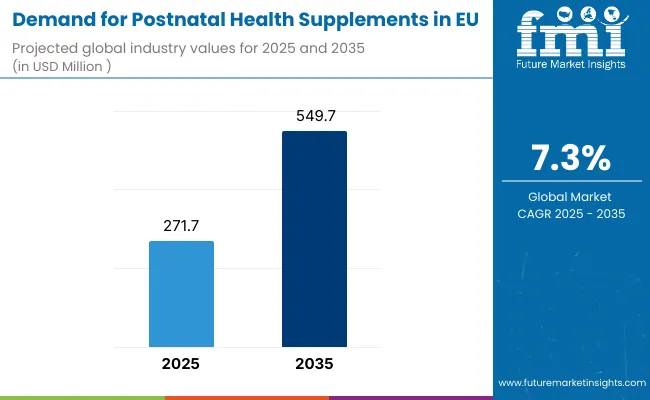
Between 2025 and 2030, EU postnatal health supplements demand is projected to expand from USD 271.7 million to USD 385.6 million, resulting in a value increase of USD 113.9 million, which represents 41.3% of the total forecast growth for the decade. This phase of development will be shaped by rising awareness among new mothers about nutritional depletion during pregnancy and lactation, increasing healthcare provider recommendations for postnatal supplementation, and growing recognition that maternal nutrition directly impacts infant health through breastfeeding. Manufacturers are expanding their product portfolios to address the evolving preferences for comprehensive formulations, organic certifications, and specialized supplements targeting specific postpartum recovery needs including iron replenishment, calcium restoration, and hormonal balance support.
From 2030 to 2035, sales are forecast to grow from USD 385.6 million to USD 549.7 million, adding another USD 161.8 million, which constitutes 58.7% of the overall ten-year expansion. This period is expected to be characterized by mainstream adoption of postnatal supplementation as standard postpartum care, integration of personalized nutrition approaches based on individual recovery needs, and development of innovative delivery formats improving compliance during the demanding early parenthood period. The growing emphasis on mental health support through nutritional interventions and increasing understanding of micronutrient roles in postpartum recovery will drive demand for scientifically-formulated products that support physical recovery, emotional wellbeing, and optimal lactation.
Between 2020 and 2025, EU postnatal health supplements sales experienced steady expansion at a CAGR of 6.5%, growing from USD 198.3 million to USD 271.7 million. This period was driven by increasing maternal age requiring enhanced nutritional support, rising awareness of postpartum depletion syndrome, and growing recognition that traditional diets may not meet increased nutritional demands during breastfeeding. The industry developed as healthcare systems increasingly emphasized preventive maternal care and supplement manufacturers recognized the underserved postnatal market opportunity. Product innovations, clinical validation studies, and educational initiatives began establishing consumer confidence and healthcare provider endorsement for specialized postnatal formulations.
Industry expansion is being supported by the rapid evolution in maternal healthcare approaches across European countries and the corresponding demand for evidence-based nutritional interventions that support optimal recovery from pregnancy and childbirth while maintaining adequate nutrition for breastfeeding mothers. Modern healthcare providers increasingly recommend postnatal supplements as essential components of postpartum care protocols, driving demand for products that address multiple recovery needs including nutrient repletion after pregnancy depletion, hormonal balance support during adjustment periods, and enhanced nutrition for quality breast milk production supporting infant development.
The growing body of clinical research demonstrating the importance of maternal nutrition for both mother and infant health outcomes is driving demand for scientifically-formulated postnatal supplements from manufacturers with appropriate research credentials and quality certifications. Healthcare authorities and professional organizations are increasingly establishing guidelines for postnatal nutrition, including specific recommendations for vitamin D, iron, DHA, and other critical nutrients during the postpartum period. Scientific studies are providing evidence supporting targeted supplementation benefits, including reduced postpartum depression risk, improved energy levels, and enhanced infant development through optimized breast milk composition, requiring specialized formulations that address the unique nutritional demands of the postnatal period distinct from prenatal requirements.
Sales are segmented by product type (ingredient), application, distribution channel, nature, and country. By product type, demand is divided into vitamins & minerals, herbal, protein & amino acid, prebiotic, and probiotic supplements. Based on application, sales are categorized into general well-being & lactation, immune & digestive health, bone & joint health, heart health, eye health, and weight management. In terms of distribution channel, demand is segmented into store-based retailing and online retailing. By nature, sales are classified into organic and conventional. Regionally, demand is focused on Germany, France, Italy, Spain, the Netherlands, and the Rest of Europe.
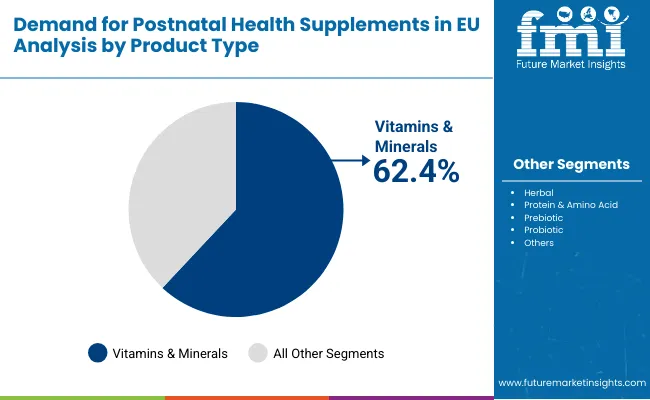
The vitamins & minerals segment is projected to account for 62.4% of EU postnatal health supplements sales in 2025, declining slightly to 60.0% by 2035, establishing itself as the foundational category addressing core nutritional needs during the postpartum period. This commanding position is fundamentally supported by scientific evidence demonstrating widespread micronutrient depletion following pregnancy, established clinical protocols recommending vitamin and mineral supplementation, and consumer familiarity with these essential nutrients. The segment delivers comprehensive nutritional support, providing mothers with critical nutrients including iron for blood restoration, calcium for bone health maintenance, vitamin D for immune function, and B vitamins for energy metabolism essential during the demanding postnatal period.
This segment benefits from extensive clinical validation, healthcare provider recommendations, and established safety profiles that build consumer confidence in daily supplementation routines. The vitamins & minerals offer advantages in standardized dosing, quality control precision, and combination formulations that address multiple nutritional needs through single products, supported by pharmaceutical-grade manufacturing ensuring consistent potency and bioavailability.
Key advantages:
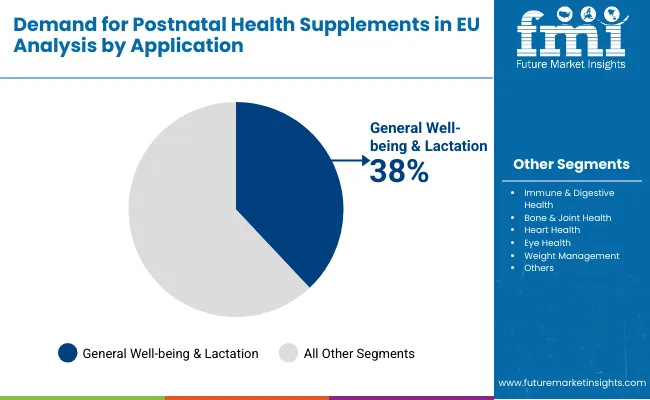
General well-being & lactation support is positioned to represent 38.0% of total postnatal supplements demand across European operations in 2025, moderating slightly to 36.0% by 2035, reflecting the segment's dominance as the primary health concern for new mothers. This considerable share directly demonstrates that overall wellness and breastfeeding support represent core motivations, with mothers seeking supplements that enhance energy levels, support milk production, and promote general recovery from childbirth.
Modern mothers increasingly view postnatal supplements as essential support systems, driving demand for products optimized for comprehensive wellness including multivitamin complexes addressing broad nutritional needs, galactagogue herbs supporting milk production, and adaptogenic ingredients managing stress during early parenthood. The segment benefits from continuous innovation focused on combination formulas, convenient dosing schedules compatible with newborn care routines, and pleasant delivery formats overcoming taste aversions common during the postpartum period.
Key drivers:
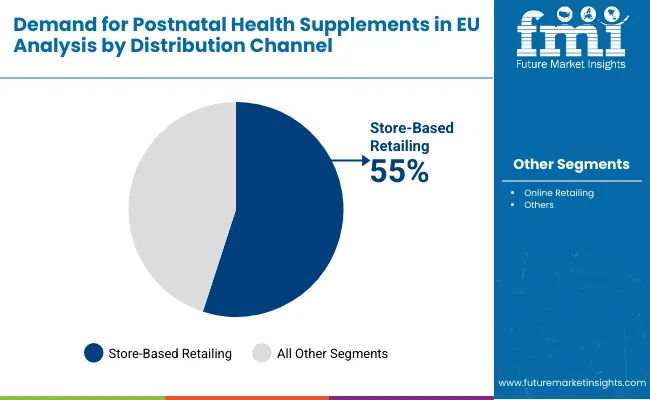
Store-based retailing is strategically estimated to control 55.0% of total European postnatal supplements sales in 2025, declining to 49.0% by 2035, reflecting the channel's importance for product discovery and professional guidance while facing growing online competition. European pharmacies, drugstores, and specialty retailers consistently provide trusted environments for postnatal supplement purchases, offering professional consultation, immediate availability, and personal interaction valuable for new mothers navigating supplement choices.
The segment provides essential touchpoints through pharmacy consultations where trained professionals offer personalized recommendations, baby specialty stores creating convenient one-stop shopping for maternal and infant needs, and health food stores emphasizing organic and natural options appealing to quality-conscious mothers. Major European pharmacy chains, including Boots, DM, Rossmann, and independent pharmacies, systematically expand postnatal supplement selections, often featuring dedicated maternal health sections and trained staff supporting informed purchase decisions.
Success factors:
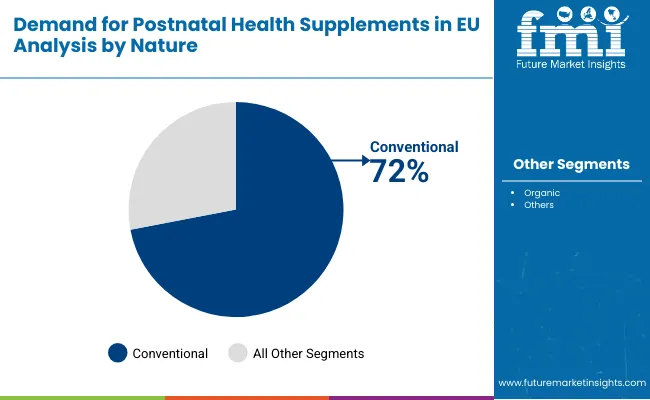
Conventional postnatal health supplements are strategically positioned to contribute 72.0% of total European sales in 2025, declining to 65.0% by 2035, representing products manufactured through standard processes without organic certification requirements. These conventional products successfully deliver accessible pricing essential for budget-conscious new families while ensuring pharmaceutical-grade quality and comprehensive nutritional coverage that prioritizes efficacy over organic credentials.
Conventional production serves mainstream consumers, healthcare system recommendations, and insurance-covered supplements where cost-effectiveness determines accessibility. The segment derives significant competitive advantages from established manufacturing infrastructure, economies of scale enabling affordable pricing, and extensive clinical validation using conventional ingredients supporting healthcare provider confidence and recommendation patterns.
Competitive advantages:
EU postnatal health supplements sales are advancing rapidly due to increasing maternal age requiring enhanced recovery support, growing awareness of postpartum nutritional depletion, and rising emphasis on maternal mental health through nutritional interventions. The industry faces challenges, including limited awareness among first-time mothers about postnatal supplementation importance, cost barriers for premium formulations during financially strained early parenthood, and confusion about appropriate supplementation during breastfeeding. Continued innovation in formulation science and education remains central to industry development.
The rapidly accelerating development of personalized nutrition technologies is fundamentally transforming postnatal supplementation from one-size-fits-all products to customized formulations, enabling targeted support previously unattainable through standard supplements. Advanced assessment platforms featuring nutrient testing, genetic analysis, and recovery monitoring allow companies to create personalized supplement protocols addressing individual depletion patterns, recovery trajectories, and breastfeeding status with precision meeting specific maternal needs. These personalization innovations prove particularly transformative for women with complicated deliveries, multiple pregnancies, or pre-existing conditions, where standardized supplements may inadequately address unique nutritional requirements.
Major supplement manufacturers invest heavily in digital health platforms, biomarker testing partnerships, and algorithm development, recognizing that personalization represents breakthrough solutions for efficacy optimization and consumer engagement. Companies collaborate with healthcare providers, nutritionists, and technology firms to develop scalable personalization systems that balance customization benefits with commercial viability and regulatory compliance supporting sustainable business models.
Modern postnatal supplement producers systematically incorporate ingredients targeting mood support, stress management, and cognitive function, recognizing postpartum mental health as critical recovery component requiring nutritional intervention alongside traditional therapies. Strategic integration of mood-supporting nutrients enables manufacturers to address postpartum depression and anxiety through evidence-based ingredients including omega-3 fatty acids, B vitamins, magnesium, and adaptogenic herbs where nutritional support complements medical treatment. These mental health formulations prove essential for comprehensive postpartum care, as healthcare systems increasingly recognize nutrition's role in maternal mental wellbeing affecting both mother and infant outcomes.
Companies implement extensive research programs investigating nutrient-mood connections, clinical trials validating mental health benefits, and safety assessments ensuring compatibility with breastfeeding, including interaction studies, milk transfer analysis, and infant safety monitoring. Manufacturers leverage mental health positioning in marketing communications, highlighting emotional wellbeing support, stress resilience benefits, and cognitive function enhancement, positioning supplements as holistic recovery aids beyond physical nutrition.
European mothers increasingly demand transparency regarding ingredient sourcing, environmental impact, and ethical production practices, driving manufacturers toward sustainable supply chains and responsible manufacturing that aligns with maternal values. This sustainability trend enables companies to build brand loyalty through shared values, command premium pricing through ethical positioning, and differentiate products in competitive markets where conscious consumption influences purchase decisions. Sustainable sourcing proves particularly important for millennial and Gen-Z mothers where environmental and social responsibility directly determines brand selection and long-term loyalty.
The development of traceable supply chains, certified sustainable ingredients, and eco-friendly packaging expands manufacturers' abilities to meet sustainability demands while maintaining product efficacy and safety standards. Brands collaborate with certification bodies, environmental organizations, and ethical sourcing initiatives to develop comprehensive sustainability programs balancing environmental responsibility with nutritional quality, supporting premium positioning while meeting regulatory requirements and consumer expectations.
EU postnatal health supplements sales are projected to grow from USD 271.7 million in 2025 to USD 549.7 million by 2035, registering a robust CAGR of 7.3% over the forecast period. The Netherlands is expected to demonstrate the strongest growth trajectory with a 7.9% CAGR, supported by progressive maternal healthcare policies, high female workforce participation requiring recovery support, and early adoption of nutritional innovations. Spain follows with 7.5% CAGR, attributed to improving maternal healthcare infrastructure and increasing awareness of postnatal nutrition importance.
Germany maintains the largest share at 30.8% in 2025, driven by comprehensive healthcare coverage and established maternal support systems, while growing at 6.9% CAGR. France follows with 21.5% share and 7.4% CAGR growth reflecting strong pharmacy distribution. Italy demonstrates 7.3% CAGR, aligning with overall market growth.
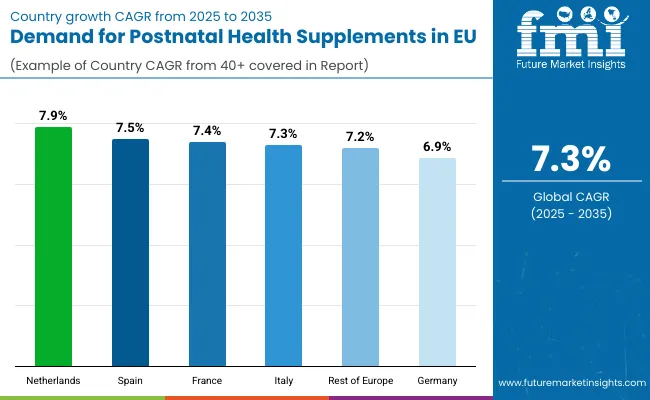
| Country | CAGR % (2025-2035) |
|---|---|
| Netherlands | 7.9% |
| Spain | 7.5% |
| France | 7.4% |
| Italy | 7.3% |
| Rest of Europe | 7.2% |
| Germany | 6.9% |
EU postnatal health supplements sales demonstrate differentiated growth trajectories across major European economies, with smaller progressive markets outpacing larger established ones through 2035, driven by varying healthcare system support, maternal workforce participation rates, and cultural attitudes toward supplementation. Netherlands shows exceptional growth from USD 14.3 million in 2025 to USD 30.8 million by 2035 at 7.9% CAGR. Spain expands robustly from USD 40.1 million to USD 82.3 million at 7.5% CAGR. France records strong growth from USD 58.5 million to USD 119.8 million at 7.4% CAGR. Italy demonstrates USD 46.5 million to USD 94.7 million at 7.3% CAGR. Rest of Europe shows USD 29.6 million to USD 59.7 million at 7.2% CAGR. Germany maintains steady expansion from USD 83.6 million to USD 160.1 million at 6.9% CAGR.
The postnatal health supplements industry in Germany is projected to exhibit steady growth with a CAGR of 6.9% through 2035, driven by exceptionally well-developed maternal healthcare infrastructure, comprehensive insurance coverage for postnatal care, and strong cultural emphasis on maternal wellbeing throughout the country. Germany's sophisticated healthcare system and internationally recognized quality standards in pharmaceutical manufacturing create substantial demand for evidence-based postnatal supplements across pharmacy and medical channels.
Major pharmacy chains, including DM, Rossmann, DocMorris, and independent Apotheken, systematically expand postnatal supplement offerings, often featuring dedicated maternal health sections with trained personnel providing professional guidance to new mothers. German demand benefits from high health insurance coverage often subsidizing prescribed supplements, substantial maternal leave policies enabling focus on recovery, and cultural acceptance of supplementation that naturally supports postnatal nutrition adoption across mainstream demographics.
The relatively moderate growth rate reflects Germany's mature market status where established supplementation patterns leave limited room for dramatic expansion, requiring innovation and premiumization rather than volume growth for value creation throughout the forecast period.
Growth drivers:
The postnatal health supplements industry in France is expanding at a CAGR of 7.4%, supported by exceptional pharmacy network providing professional maternal guidance, strong government support for maternal health, and increasing awareness of postnatal nutrition importance among French mothers. France's centralized healthcare system and pharmacy-centric supplement distribution create favorable conditions for professionally-endorsed postnatal supplements with scientific substantiation.
Major pharmacy networks, including Pharmacie Lafayette, Pharmacie Principale, and independent pharmacies, actively promote postnatal supplements through maternal health programs, professional consultations, and educational initiatives explaining nutritional needs during breastfeeding and recovery. French sales particularly benefit from strong breastfeeding culture requiring sustained nutritional support, with healthcare providers increasingly recommending specialized supplements for optimal milk production and maternal wellbeing. The country's emphasis on natural health approaches and pharmaceutical expertise creates unique positioning for high-quality postnatal formulations.
Success factors:
The postnatal health supplements industry in Italy is growing at a CAGR of 7.3%, fundamentally driven by strong family-oriented culture emphasizing maternal wellbeing, expanding awareness of nutritional importance during recovery, and growing integration of supplements into standard postnatal care protocols. Italy's evolving healthcare landscape increasingly recognizes preventive nutrition's role in maternal recovery, creating favorable conditions for supplement adoption among quality-conscious Italian mothers.
Major Italian pharmacy chains, healthcare providers, and specialty retailers actively promote postnatal supplements through maternal education programs, with particular emphasis on Mediterranean diet supplementation and natural recovery support. Italian sales particularly benefit from increasing maternal age requiring enhanced nutritional support, growing female workforce participation necessitating efficient recovery, and cultural emphasis on maternal health within extended family structures supporting supplement investment.
Development factors:
The postnatal health supplements industry in Spain is projected to grow at an impressive CAGR of 7.5%, substantially supported by rapidly modernizing maternal healthcare services, increasing female workforce participation requiring recovery optimization, and growing awareness of postnatal depletion among Spanish mothers. Spanish healthcare transformation and improving economic conditions position postnatal supplements as accessible recovery aids aligned with contemporary maternal health priorities.
Major Spanish pharmacy chains, including Farmacia Internacional, Farmacias Trébol, and hospital pharmacies, systematically introduce comprehensive postnatal supplement ranges with competitive pricing and professional guidance supporting category development. Spain's evolving social support systems for new mothers and increasing recognition of maternal mental health importance drive specific supplement applications for mood support and energy restoration. The country's improving birth rate policies and maternal leave provisions enable focus on recovery, supporting sustained supplementation throughout the postpartum period.
Growth enablers:
Demand for postnatal health supplements in the Netherlands is expanding at a leading CAGR of 7.9%, fundamentally driven by exceptional maternal healthcare policies, progressive attitudes toward maternal wellbeing, and sophisticated understanding of nutritional science among Dutch mothers. Dutch society demonstrates particular strength in work-life balance support, postnatal care services, and evidence-based health approaches positioning the Netherlands as European leader in maternal health innovation.
Netherlands sales significantly benefit from comprehensive kraamzorg (postnatal care) system providing professional support and education about recovery nutrition, high female workforce participation creating demand for efficient recovery solutions, and cultural emphasis on preventive health supporting supplement adoption. Dutch mothers' high education levels and scientific literacy enable sophisticated supplement selection based on evidence rather than marketing, driving demand for clinically-validated formulations. The country's innovative healthcare approaches and openness to nutritional interventions create favorable environment for advanced postnatal supplement adoption.
Innovation drivers:
Revenue from postnatal health supplements in Rest of Europe is expanding at 7.2% CAGR, representing diverse markets including Belgium, Austria, Poland, Scandinavian countries, and Eastern European nations experiencing varied maternal health development stages. These markets collectively demonstrate growing potential as healthcare systems modernize, maternal support policies expand, and awareness of postnatal nutrition importance increases across previously underserved populations.
Nordic countries particularly show strong adoption driven by excellent maternal healthcare systems and gender equality supporting maternal wellbeing investment, while Eastern European markets represent growth opportunities as economic development enables premium supplement purchases and healthcare infrastructure improvements support distribution expansion.
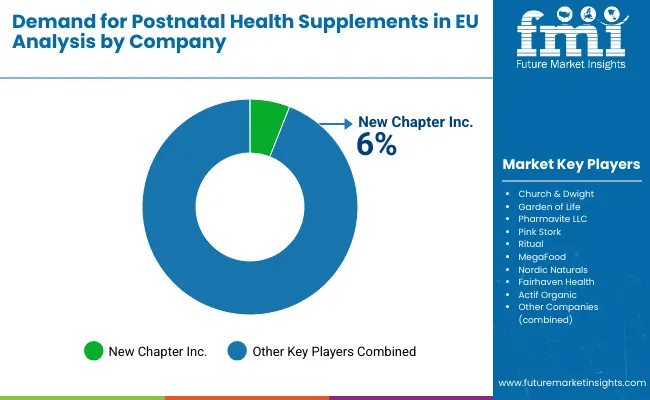
EU postnatal health supplements sales are defined by competition among specialized maternal nutrition companies, established supplement manufacturers, and emerging brands focusing on women's health. Companies are investing in clinical research, formulation innovation, healthcare provider engagement, and educational initiatives to deliver scientifically-validated, safe, and effective postnatal solutions. Strategic partnerships with healthcare systems, maternity hospitals, and maternal health organizations emphasizing clinical credibility and professional endorsement are central to strengthening competitive position.
Major participants include New Chapter Inc. with an estimated 6.0% share, leveraging its organic positioning, whole-food philosophy, and strong pharmacy presence through premium maternal formulations. New Chapter benefits from fermented nutrient technology, comprehensive prenatal-postnatal product lines, and established relationships with natural health retailers supporting brand recognition among health-conscious mothers.
Church & Dwight holds approximately 5.5% share through its maternal health portfolio, emphasizing broad retail distribution, competitive pricing, and trusted brand heritage. The company's success in mainstream retail channels and ability to provide accessible postnatal nutrition creates strong positioning among value-conscious consumers.
Garden of Life accounts for roughly 4.5% share through its position as premium organic supplement leader with strong specialty retail presence, providing clean-label postnatal formulations through certified organic ingredients. The company benefits from comprehensive women's health expertise, scientific validation, and marketing excellence targeting educated, health-conscious mothers.
Other key players including Pharmavite (3.5%), Pink Stork (3.0%), and Ritual (2.5%) collectively with additional companies hold 75.0% share, reflecting the fragmented nature of European postnatal supplements market where numerous specialized brands, regional manufacturers, and emerging direct-to-consumer companies serve specific consumer segments and distribution channels.
| Item | Value |
|---|---|
| Quantitative Units | USD 549.7 million |
| Product Type (Ingredient) | Vitamins & Minerals, Herbal, Protein & Amino Acid, Prebiotic, Probiotic |
| Application | General Well-being & Lactation, Immune & Digestive Health, Bone & Joint Health, Heart Health, Eye Health, Weight Management |
| Distribution Channel | Store-Based Retailing, Online Retailing |
| Nature | Organic, Conventional |
| Countries Covered | Germany, France, Italy, Spain, the Netherlands, and the Rest of Europe |
| Key Companies Profiled | New Chapter, Church & Dwight, Garden of Life, Pharmavite, Pink Stork, Ritual |
| Additional Attributes | Dollar sales by product type, application, distribution channel, and nature; regional demand trends across major European economies; competitive landscape analysis with specialized maternal nutrition companies; consumer preferences for various supplement formats and ingredients; integration with maternal healthcare systems; innovations in personalized nutrition and mental health support; adoption across pharmacy and online channels; regulatory framework for maternal supplements; educational initiatives and healthcare provider engagement; penetration analysis for organic and sustainable products |
Product Type (Ingredient)
The global demand for postnatal health supplements in EU is estimated to be valued at USD 271.7 million in 2025.
The market size for the demand for postnatal health supplements in EU is projected to reach USD 549.7 million by 2035.
The demand for postnatal health supplements in EU is expected to grow at a 7.3% CAGR between 2025 and 2035.
The key product types in demand for postnatal health supplements in EU are vitamins & minerals, herbal, protein & amino acid, prebiotic and probiotic.
In terms of application, general well-being & lactation segment to command 38.0% share in the demand for postnatal health supplements in EU in 2025.






Our Research Products

The "Full Research Suite" delivers actionable market intel, deep dives on markets or technologies, so clients act faster, cut risk, and unlock growth.

The Leaderboard benchmarks and ranks top vendors, classifying them as Established Leaders, Leading Challengers, or Disruptors & Challengers.

Locates where complements amplify value and substitutes erode it, forecasting net impact by horizon

We deliver granular, decision-grade intel: market sizing, 5-year forecasts, pricing, adoption, usage, revenue, and operational KPIs—plus competitor tracking, regulation, and value chains—across 60 countries broadly.

Spot the shifts before they hit your P&L. We track inflection points, adoption curves, pricing moves, and ecosystem plays to show where demand is heading, why it is changing, and what to do next across high-growth markets and disruptive tech

Real-time reads of user behavior. We track shifting priorities, perceptions of today’s and next-gen services, and provider experience, then pace how fast tech moves from trial to adoption, blending buyer, consumer, and channel inputs with social signals (#WhySwitch, #UX).

Partner with our analyst team to build a custom report designed around your business priorities. From analysing market trends to assessing competitors or crafting bespoke datasets, we tailor insights to your needs.
Supplier Intelligence
Discovery & Profiling
Capacity & Footprint
Performance & Risk
Compliance & Governance
Commercial Readiness
Who Supplies Whom
Scorecards & Shortlists
Playbooks & Docs
Category Intelligence
Definition & Scope
Demand & Use Cases
Cost Drivers
Market Structure
Supply Chain Map
Trade & Policy
Operating Norms
Deliverables
Buyer Intelligence
Account Basics
Spend & Scope
Procurement Model
Vendor Requirements
Terms & Policies
Entry Strategy
Pain Points & Triggers
Outputs
Pricing Analysis
Benchmarks
Trends
Should-Cost
Indexation
Landed Cost
Commercial Terms
Deliverables
Brand Analysis
Positioning & Value Prop
Share & Presence
Customer Evidence
Go-to-Market
Digital & Reputation
Compliance & Trust
KPIs & Gaps
Outputs
Full Research Suite comprises of:
Market outlook & trends analysis
Interviews & case studies
Strategic recommendations
Vendor profiles & capabilities analysis
5-year forecasts
8 regions and 60+ country-level data splits
Market segment data splits
12 months of continuous data updates
DELIVERED AS:
PDF EXCEL ONLINE
Postnatal Health Supplements Market Trends – Demand & Forecast 2025-2035
EU Longevity Supplements Sales Analysis Size and Share Forecast Outlook 2025 to 2035
Comprehensive Analysis of Europe Pet Food Supplements Market by Nature, Form, Pet Type and Distribution Channel through 2035
Liver Health Supplements Market Analysis - Size, Growth, and Forecast 2025 to 2035
Postnatal Probiotic Supplements Market Size and Share Forecast Outlook 2025 to 2035
Immune Health Supplements Market Insights - Growth & Innovation 2025 to 2035
Hormonal Health Supplements Market – Growth, Demand & Nutritional Trends
Digestive Health Supplements Market Analysis - Size, Share, and Forecast Outlook 2025 to 2035
European Union Cross-Border Healthcare Market Analysis 2025 to 2035
Postpartum Health Supplements Market Size and Share Forecast Outlook 2025 to 2035
Kids’ Brain Health Supplements Market Size and Share Forecast Outlook 2025 to 2035
Western Europe Dietary Supplements Market Analysis by Ingredients, Form, Application, and Country Through 2025 to 2035
Older Adults Health Supplements Market Outlook - Growth, Demand & Forecast 2024 to 2034
Flavors for Pharmaceutical & Healthcare Applications Market Size and Share Forecast Outlook 2025 to 2035
Demand for Dietary Supplements in EU Size and Share Forecast Outlook 2025 to 2035
Demand for Calcium Supplements in EU Size and Share Forecast Outlook 2025 to 2035
Europe Healthcare Rigid Plastic Packaging Market Trends – 2024-2034
Demand for Fertility Supplements in EU Size and Share Forecast Outlook 2025 to 2035
Demand for Probiotic Supplements in EU Size and Share Forecast Outlook 2025 to 2035
Demand for Postbiotic Supplements in EU Size and Share Forecast Outlook 2025 to 2035

Thank you!
You will receive an email from our Business Development Manager. Please be sure to check your SPAM/JUNK folder too.
Chat With
MaRIA